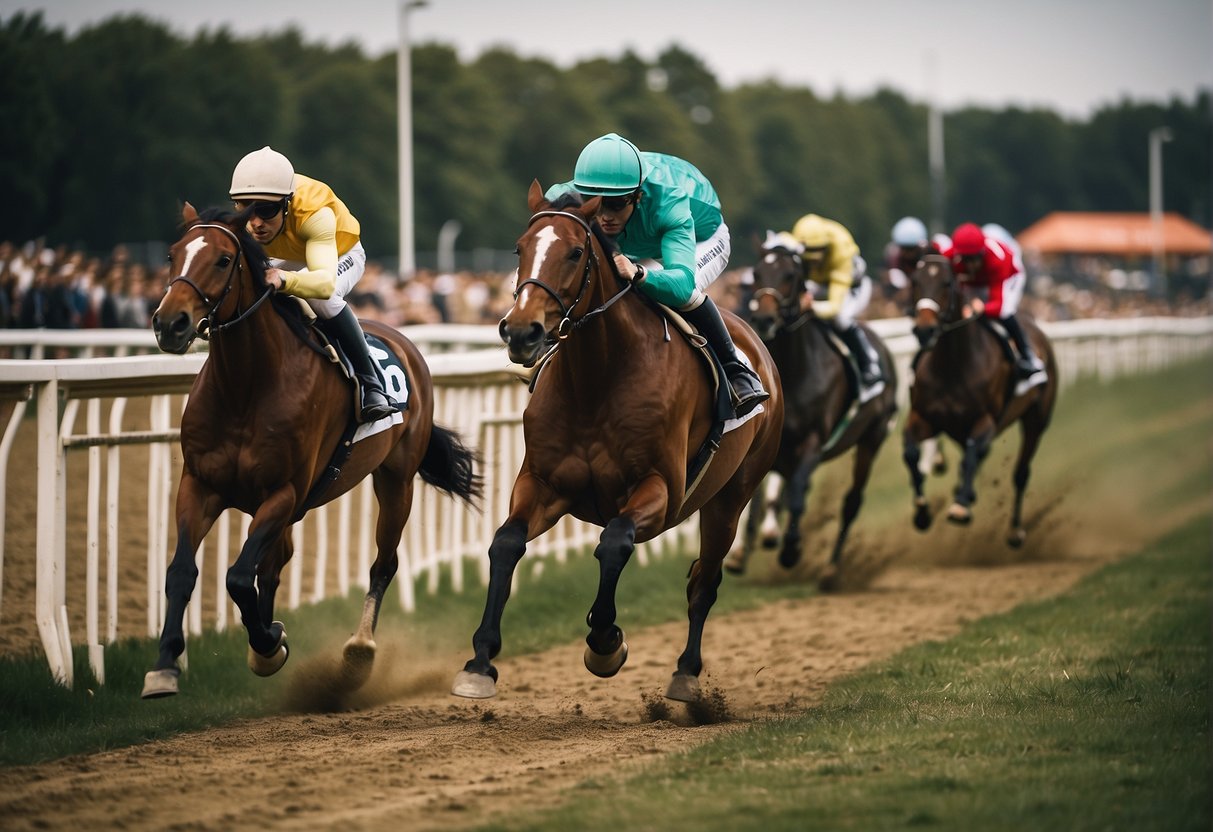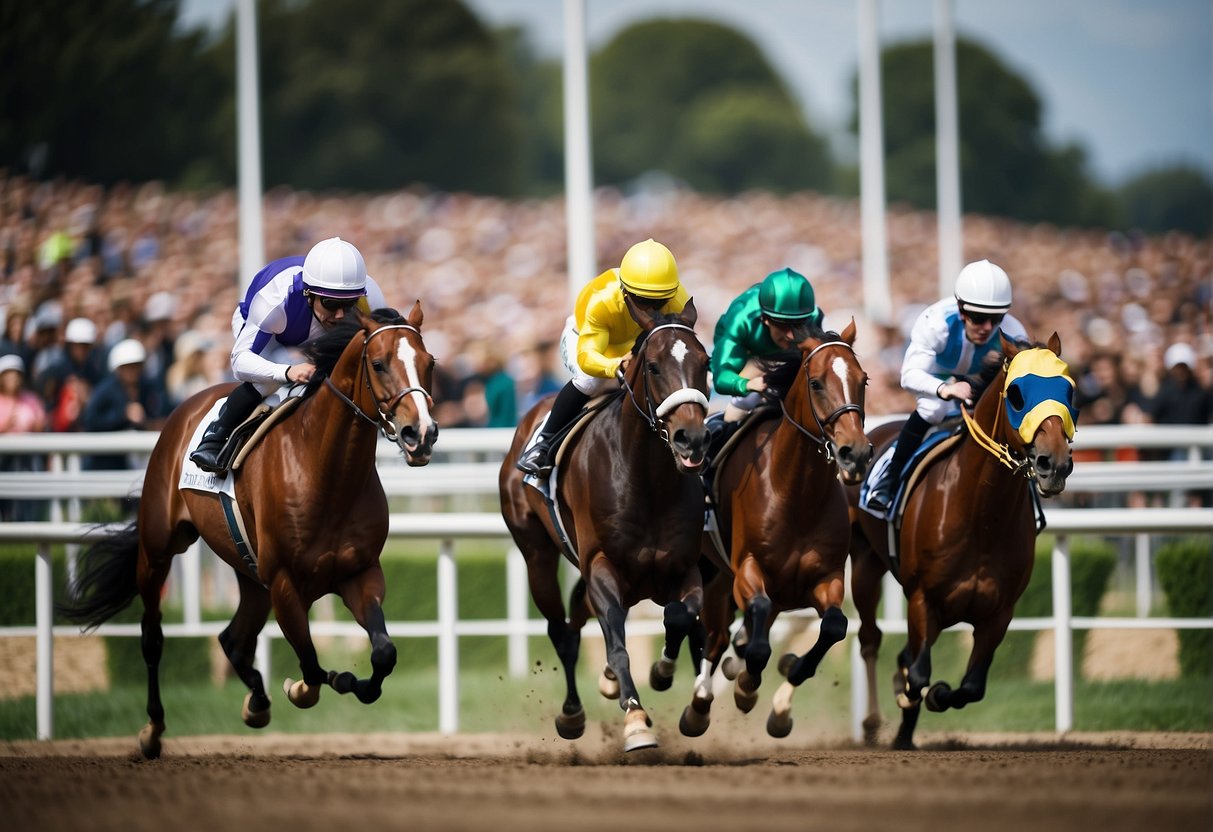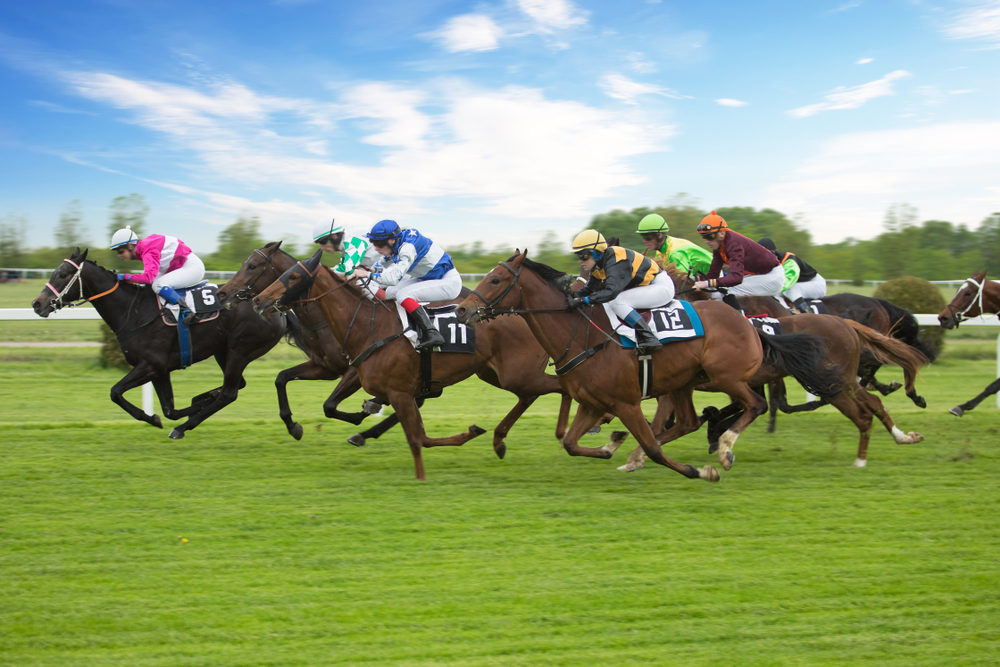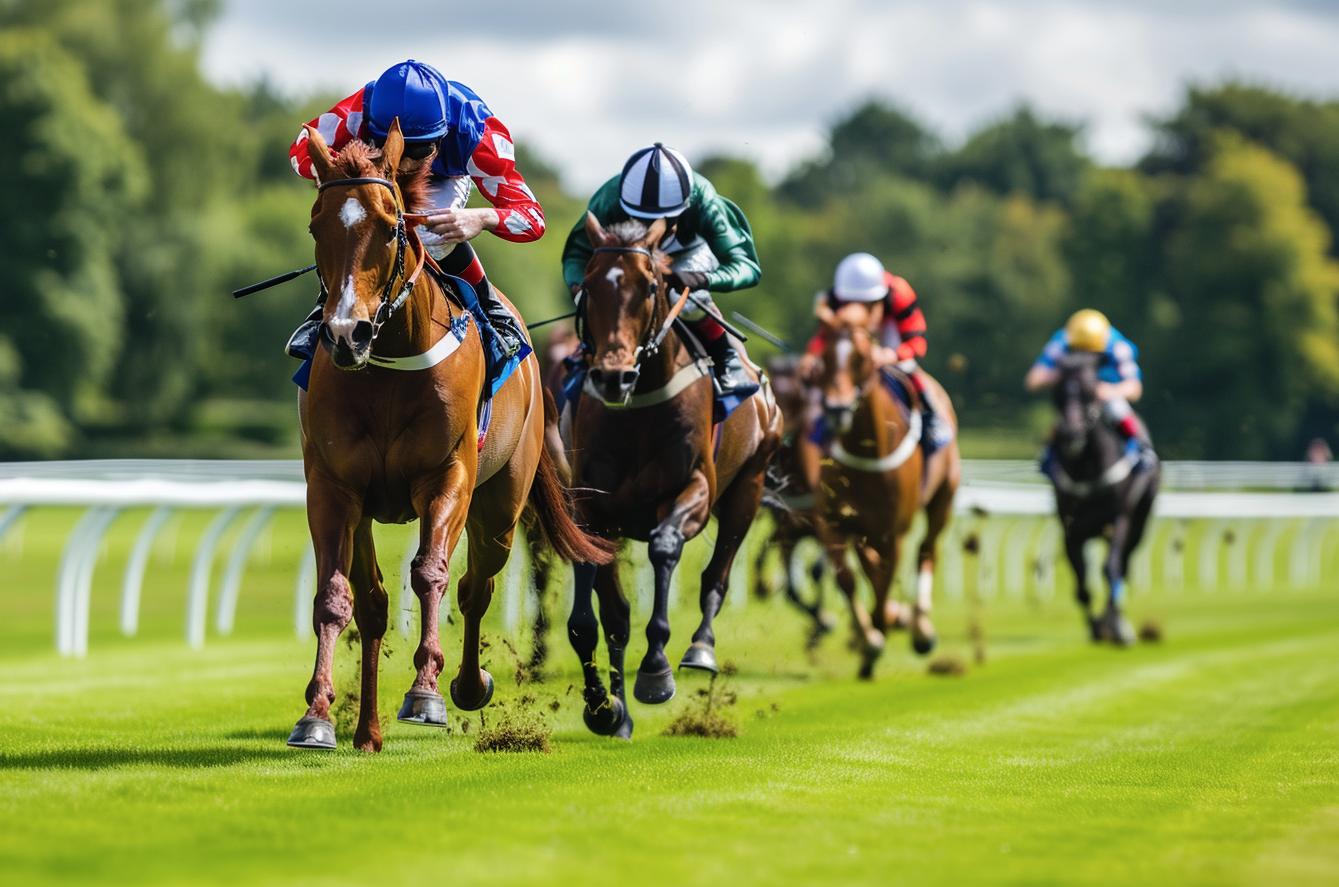Horse racing holds a distinct place in the sporting culture of the UK and Ireland, with a heritage that intertwines with the history of both nations. The sport attracts enthusiasts from the casual observer to the avid punter, all captivated by the blend of speed, strategy, and the majestic athleticism of the equine competitors. Spanning from the thunderous cheers at packed grandstands to the hushed anticipation at the starting gates, horse racing offers a spectacle that is as varied as the races themselves.

With a rich diversity, the sport sees two main types of racing: Flat racing, which takes place on level racecourses without obstacles and is synonymous with prestige and tradition; and National Hunt racing, which involves navigating through jumps or hurdles. These types embody a layered classification system that ranges from high stakes, top-grade races to more accessible, lower-tier competitions. Each type, class, and grade has its own set of rules, strategies, and challenges, providing a broad spectrum of racing experiences.
Famous races, such as the Classics in Flat racing and key events in the National Hunt calendar, are not only national pastimes but significant events that garner international attention. The iconic racecourses that house these events, like Ascot and Cheltenham, contribute to the regional character and economic vitality of the sport. Meanwhile, the expertise of jockeys and trainers remains pivotal, as it is their skills and decisions that often dictate the outcome of the races.
Key Takeaways
- Horse racing in the UK and Ireland is steeped in tradition, offering a wide array of spectacles through various race types.
- Flat and National Hunt races provide diverse challenges with their own set of classifications and grading systems.
- The sport’s economic impact, governance, and the roles of jockeys and trainers are instrumental in maintaining its integrity and appeal.
Need Help Beating the Bookies?
Our expert betting tipsters have been taking cash off the bookies since 2014! If you need a helping hand with winning then why not check them out?
Browse Our Tipsters
The Outside Edge
Simple Yet Effective Horse Racing Tips from an Experienced Industry Expert
Visit PROFILEUnderstanding Horse Racing
In the realms of UK and Ireland, horse racing stands as a multifaceted sport encompassing various race types and classifications. Grasping the intricacies of racing is essential for enthusiasts and bettors alike.
Key Concepts and Terms
Horse racing in the UK and Ireland is divided into two primary forms: Flat racing and Jump racing (also known as National Hunt racing). Flat racing is characterised by races on a straight or oval track without obstacles, and it often tests the speed and stamina of the horse. In contrast, jump racing includes hurdles or fences that horses must navigate, introducing additional challenges of agility and endurance.
- Age: A vital factor in classes of races where horses of the same age may compete against each other.
- Handicap: A race where horses carry different weights assigned by the handicapper, aiming to level the playing field.
- Weight: Refers to the amount of weight a horse carries in a race which can include the jockey, equipment, and handicap.
- Types: Broadly speaking, races are categorised into handicaps, stakes, maidens, and more.
- Rating: A system that assesses a horse’s performance and potential.
- Race Class: Ranging from Class 1 to Class 7, the class indicates the level of the race, with Class 1 being the highest.
The Importance of Horse Racing in the UK and Ireland
Horse racing holds a prestigious place in the cultural and economic fabric of the UK and Ireland. It’s not only a popular spectator sport but also a vital industry that contributes significantly to the economy. Racecourses like Ascot and Cheltenham are internationally renowned and host some of the most significant events in the racing calendar, such as The Royal Ascot and The Cheltenham Festival.
- The sport supports a wide-ranging industry encompassing breeding, training, and betting.
- Significant races such as the Classics, which include iconic events like The Derby and The Oaks, serve as benchmarks for equine excellence.
In sum, horse racing is a complex sport with a rich history in the UK and Ireland, offering diverse race types and classes, tailored to various groups of horses, thereby providing a dynamic experience for participants and spectators.
Types of Horse Racing

In the United Kingdom and Ireland, horse racing is a sport rich in heritage, encompassing various types of races that demand different levels of endurance and speed from the thoroughbreds involved.
Flat Racing
Flat racing tests the speed and stamina of the horse on a level track without any obstacles. Races vary in distance, typically ranging from 5 furlongs to over 2 miles. These races take place on turf and are a true test of acceleration and pace.
National Hunt Racing
National Hunt racing involves horses navigating through a series of obstacles, either hurdles or fences. Hurdle races require horses to jump over barriers that are a minimum of 3 and a half feet high, while steeplechases include larger fences and ditches. Endurance and jumping ability are crucial in these contests which can extend up to 4 and a half miles.
Bumpers (National Hunt Flat Races)
Bumper races serve as an introduction to National Hunt racing for horses that have not yet begun jumping. They are flat races run over a distance of 1 to 2 and a half miles on turf. These races allow horses to gain experience on the track before they move on to hurdling or chasing.
Classifications and Grading

In UK and Ireland horse racing, classifications and gradings are essential in determining the level of competition and the quality of horses that compete. Each race is categorised to reflect the calibre of the horses running, as well as to ensure fair and competitive racing.
Group and Graded Races
Group 1: The pinnacle of Flat racing, featuring the highest quality horses. Examples include the Derby and the 1,000 Guineas.
Group 2 and 3 races: Slightly lower in ranking but still feature top-quality horses, often seen as stepping stones to Group 1 races.
Graded races: Primarily for National Hunt jump racing, these are divided into Grade 1, Grade 2, and Grade 3, with Grade 1 being the highest echelon, such as the Cheltenham Gold Cup.
Handicap Races
Handicap races: These contests aim to give each horse an equal chance of winning by assigning different weights based on their ability. The Official Handicapper determines the weights to level the playing field, resulting in highly competitive racing. Ratings bands in handicaps are divided into classes from Class 1 to Class 6, with Class 1 featuring the highest-rated horses.
Classified Stakes and Conditions Stakes
Conditions stakes: Races where horses carry weight based on certain criteria like age, sex, and past wins. These races are not handicaps because the weight each horse carries is determined by set conditions rather than individual ratings.
Classified stakes: Similar to conditions stakes but are often used to classify horses for future handicap races.
Maiden and Novice Races
Maiden races: Contests for horses who have yet to win a race. These events are critical for evaluating a horse’s potential and are divided into different classes based on the horse’s experience and capabilities.
Novice races: Designed for horses that are relatively new to racing, typically having won no more than two races. The term ‘novice’ applies for a full racing season after a horse wins its first race, ensuring horses compete against others with similar experience.
Iconic Racecourses and Famous Races
The United Kingdom and Ireland are steeped in horse racing tradition, hosting some of the most prestigious races and iconic racecourses in the world. Each race and venue carries a legacy that has shaped the sport of kings.
Classic Races and their Heritage
The Classics are quintessential to British horse racing, consisting of five premier flat races which are the pinnacle for three-year-old thoroughbreds.
- The 2,000 Guineas: This one-mile contest held at Newmarket Racecourse is a test of speed and stamina for colts.
- The 1,000 Guineas: Also at Newmarket, this mile race mirrors the 2,000 Guineas, but is exclusively for fillies.
- The Oaks: Epsom Racecourse sets the stage for this one mile, four furlong race, a definitive test for three-year-old fillies.
- The Derby: Renowned worldwide, held at Epsom, this one mile, four furlong race is arguably the most prestigious of the Classics.
- The St Leger: Doncaster Racecourse hosts this enduring test over one mile, six furlongs and 132 yards, rounding off the Classic season.
These races not only define the careers of horses but also mark the high points of the British flat racing calendar.
Notable Racecourses
Each racecourse in the UK and Ireland holds its own charm and history, attracting visitors from around the globe:
- Newmarket Racecourse: Known as the headquarters of British horse racing, it conducts the 2,000 and 1,000 Guineas each year.
- Epsom Racecourse: The Derby and The Oaks highlight the prominence of this Surrey-based course.
- Doncaster Racecourse: Home of The St Leger, it boasts a heritage stretching back to the late 16th century.
These venues are celebrated for their distinctive characteristics and play a crucial role in hosting these historic events.
The Grand National and Cheltenham Gold Cup
The Grand National is held at Aintree Racecourse and stands as a legendary steeplechase that has captivated audiences since the 19th century. This challenging four miles two furlong race is a pinnacle for jump racing, and encapsulates the adventure of the sport.
The Cheltenham Gold Cup is a premier event of the National Hunt season held at Cheltenham Racecourse. Spanning over three miles and two and a half furlongs, the Gold Cup is a testament to endurance and agility, attracting elite horses and jockeys that solidify its status as a marquee event.
These races are more than competitions; they are cultural institutions that reflect the heritage and heart of horse racing in the UK and Ireland.
The Role of Jockeys and Trainers
In the intricate world of horse racing in the UK and Ireland, jockeys and trainers play pivotal roles with their expertise crucial to both the strategy and outcome of races. Their responsibilities encompass the physical preparation and strategic planning necessary for success.
Weight and Handicap Systems
Trainers are responsible for ensuring that their horses are in peak condition and prepared to handle the weights they are assigned in handicap races. The weight a horse carries is determined by its official rating, a numeric expression of its past performances. A higher rating results in a horse carrying more weight, a system designed to level the competitive field.
In this context, jockeys must be acutely aware of the handicap system as it influences race strategy. They are often tasked with managing the following:
- Their own body weight to meet riding requirements
- The impact of the horse’s assigned weight on race tactics
Success and Reputation
The success of a jockey or trainer can significantly influence their reputation within the racing community. This success is often quantified by:
| Metric | Description |
|---|---|
| Win percentage | The ratio of wins to total races |
| Earnings | Prize money garnered from races |
| Notable victories | High-profile race wins such as at the Cheltenham Festival or Royal Ascot |
Trainers and jockeys frequently establish partnerships where their collective efforts and understanding of each other’s techniques can lead to consistent performances and improved chances of success. The reputation of a jockey or trainer can affect their opportunities, as owners often seek out those with a proven record for their racing enterprises.
Race Conditions and Strategy
The performance of horses in UK and Irish racing can be significantly influenced by varying race conditions and carefully crafted strategies. Understanding these factors is critical for trainers, jockeys, and punters.
Analysing Course Types and Conditions
Courses across the UK and Ireland present diverse challenges, from the undulating terrains of Cheltenham to the flat, speedy stretches of Ascot. Condition plays an essential role; for instance, weather can affect the ground’s firmness, demanding different levels of stamina and speed from the horses. The presence of fences in National Hunt races adds another layer of complexity, requiring precise judgement and agility.
- Flat courses: Demand speed and acceleration.
- Jump courses: Require endurance and nimble navigation over fences.
On a softer track, horses with greater stamina thrive, while firmer grounds favour those with explosive speed. The type of surface — turf, all-weather, or synthetic — also impacts race outcomes.
Strategies for Different Types of Races
Strategies for flat and jump races vary as they pose different demands on the equines. In flat races, it’s critical to understand the optimum point to encourage a horse to accelerate, considering the distance and the horse’s ability to sustain speed. For longer races, conserving energy for a final sprint can be a deciding factor.
For jump racing, the approach involves:
- Pacing: A steady pace to conserve energy for the entire course.
- Jumping: Efficiently clearing fences to avoid falls or slowdowns.
Select strategies for different race types:
- Handicap races: Weights are balanced based on ability, so strategic placement and timing are pivotal.
- Group races: High-quality fields where tactical awareness about when to break from the pack is crucial.
A jockey must be attuned to the race’s dynamics and the horse’s response to conditions to execute these strategies effectively.
Horse Racing Governance and Regulation
In the United Kingdom, the governance and regulation of horse racing are underpinned by a detailed framework designed to ensure fair play, safety, and integrity within the sport. This framework is enforced by a central authority responsible for upholding the rules and standards of racing.
British Horse Racing Authority (BHA)
The British Horse Racing Authority (BHA) stands at the helm of thoroughbred racing in Great Britain. It serves as the governing and regulatory body responsible for the sport. The BHA enforces Rules of Racing and General Instructions that are pivotal in administering various aspects of British horse racing, including but not limited to, anti-doping, ownership, and commercial arrangements.
- Rules: The BHA lays down comprehensive Rules of Racing that all participants must adhere to. These rules cover the conduct of races, the responsibilities of trainers and owners, registration processes, and disciplinary procedures.
- Regulations: Regulations go hand-in-hand with rules, setting out the details of implementation and control. This includes guidelines on betting activities connected to the races, licensing of personnel, and the welfare of the horses participating in events.
The BHA remains actively involved in updating and revising these rules and regulations to adapt to contemporary standards and practices within the sport. Instances such as the recent changes due to COVID-19 have shown the BHA’s commitment to maintaining the integrity and continuity of horse racing in changing circumstances.
Economic Aspects of Horse Racing
The economic landscape of horse racing in the UK and Ireland is multifaceted, with significant contributions to the economy arising from prize money, auctions, and the betting industry.
Prize Money and Auctions
Prize money constitutes a crucial incentive in horse racing, attracting owners and trainers to compete at high-profile events. In the UK, the purses vary, with elite Group races offering substantial rewards. For instance, premiere races like The Derby or The Grand National can offer prize funds reaching into the millions. Auctions, where yearlings and racehorses change hands, are pivotal moments in the economic cycle of the industry. They serve as barometers of market health, with top-priced horses often reaching several hundred thousand pounds, and in some cases, millions.
Betting and the Impact on Economy
Betting is an integral part of horse racing’s economic engine. It’s not only a popular pastime but also a significant contributor to the economy. In the UK, the betting industry is linked to horse racing through a system of levies that directly fund the sport. Bookmakers offer odds on races across 59 racecourses, with major events like the Cheltenham Festival and Ascot drawing immense betting volumes. The turnover from betting infuses life into the economy, with the British Horseracing Authority (BHA) highlighting the industry’s generation of over £4.1 billion annually, including direct, indirect, and associated expenditure, much of which benefits rural economies and supports over 20,000 jobs.
Frequently Asked Questions
This section addresses common queries regarding the intricacies of horse racing across the UK and Ireland, including race classifications and betting practices.
What are the various classifications of horse races in the UK?
In the UK, horse races are classified principally as Flat or National Hunt. Flat races are held on level tracks without obstacles, while National Hunt races involve navigating hurdles or fences.
Could you explain the different classes and groups in UK horse racing?
UK horse racing features various classes (1-7) to indicate the racing quality, with Class 1 being the highest. Within Class 1, races are divided into Group races (1-3) for the flat, with Group 1 being the most prestigious.
What are the elite Group 1 races within the UK and how do they differ from other groups?
Group 1 races in the UK represent the highest level of competition, attracting the finest horses with significant prize money and international recognition. They differ from other groups by the quality of the competitors and the stringent entry conditions.
How does horse racing in Ireland vary from horse racing in the UK?
Horse racing in Ireland is similar in structure to the UK with Flat and National Hunt racing, but it has its own governing body, racecourses, and signature events like the Irish Grand National and the Irish Derby.
What are the main types of bets commonly placed in UK horse racing?
The most common bet types in UK horse racing include win bets, each-way bets, accumulators, and place bets. Each carries its own rules for winning, depending on the horse’s performance and the terms of the bet.
In UK horse racing, what constitutes a Classic race?
Classic races in UK horse racing are the most prestigious events for three-year-old horses, including the Derby, the Oaks, and the St Leger Stakes, among others. These races have a rich heritage and are key targets for breeders and trainers.





